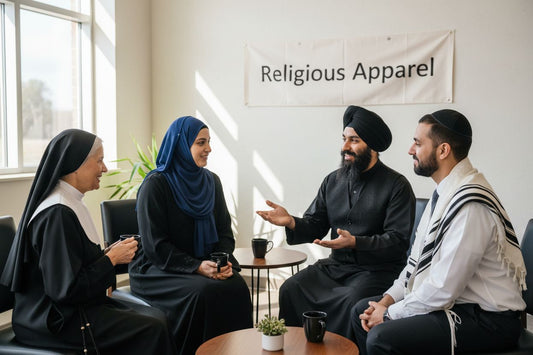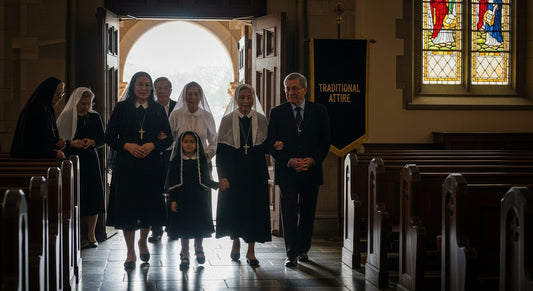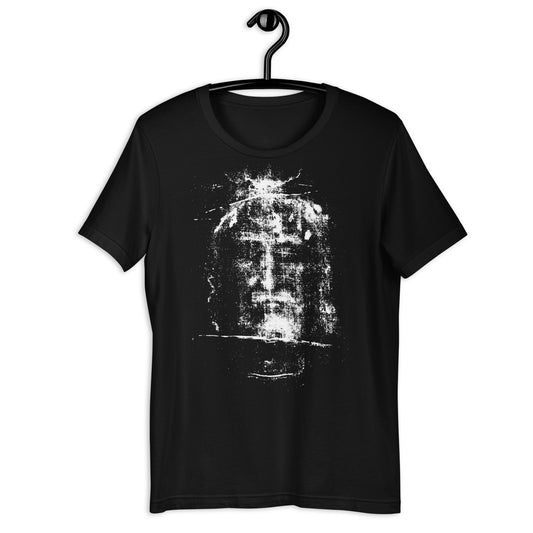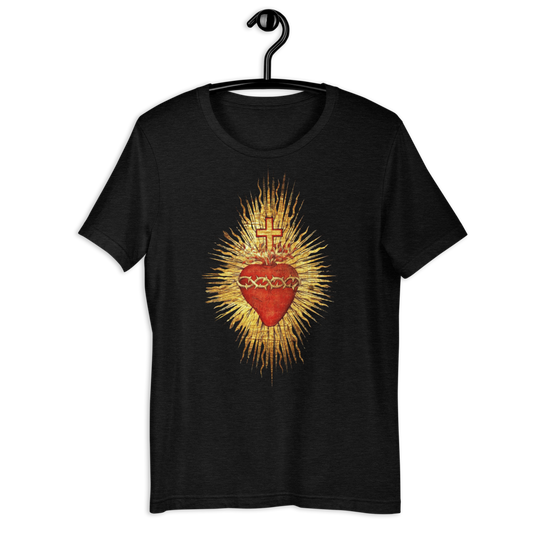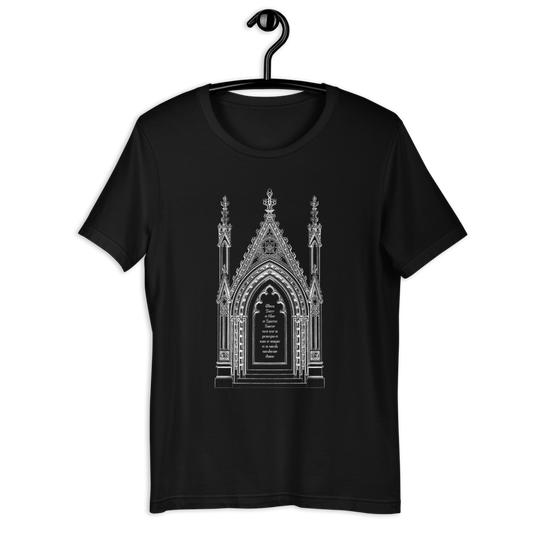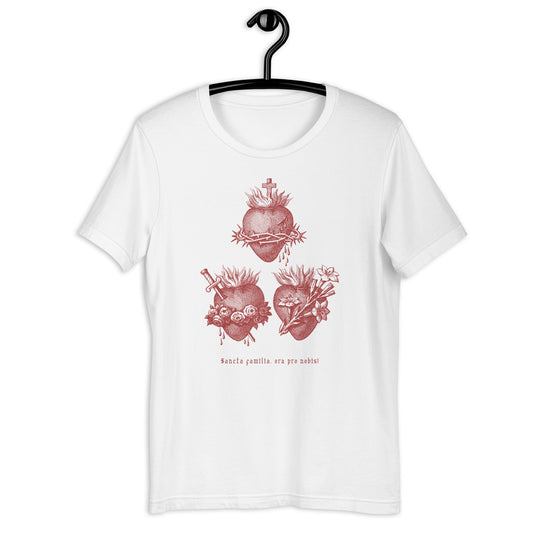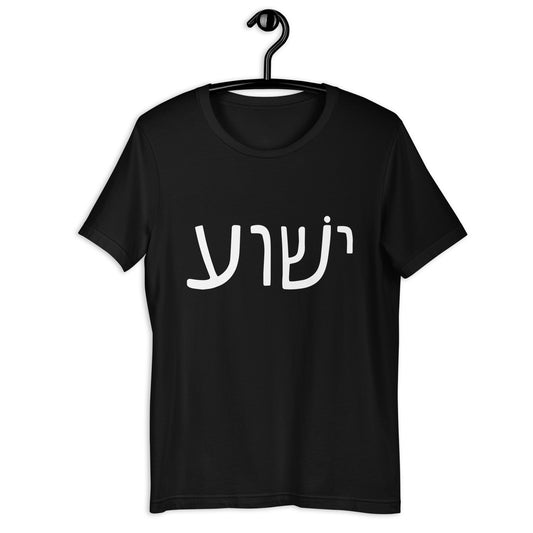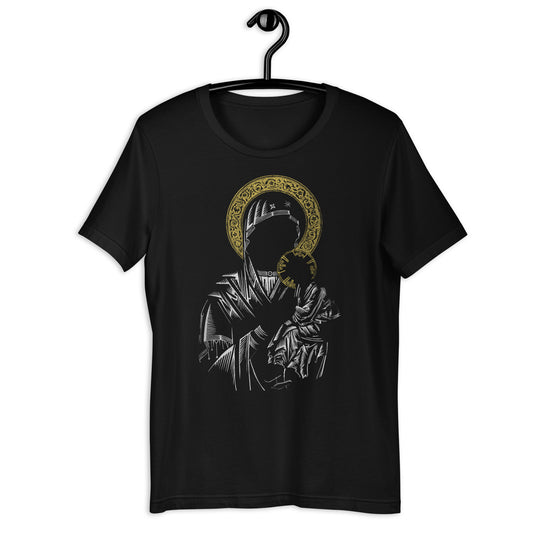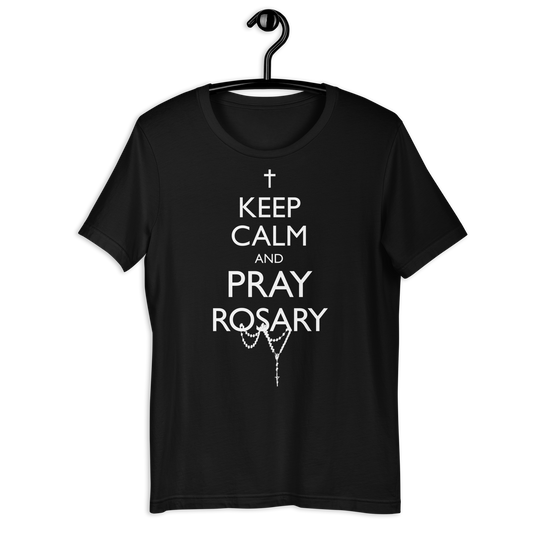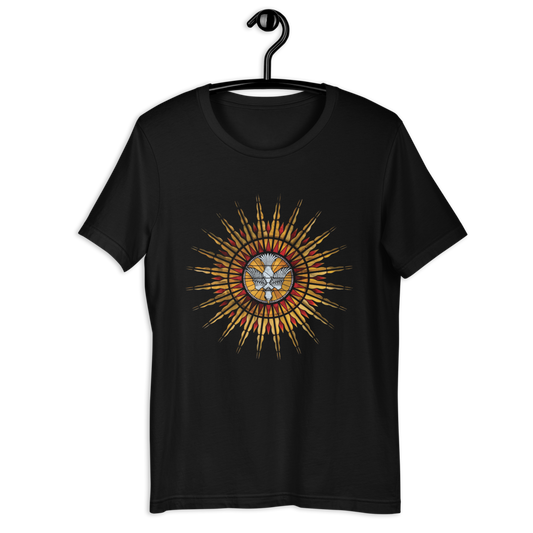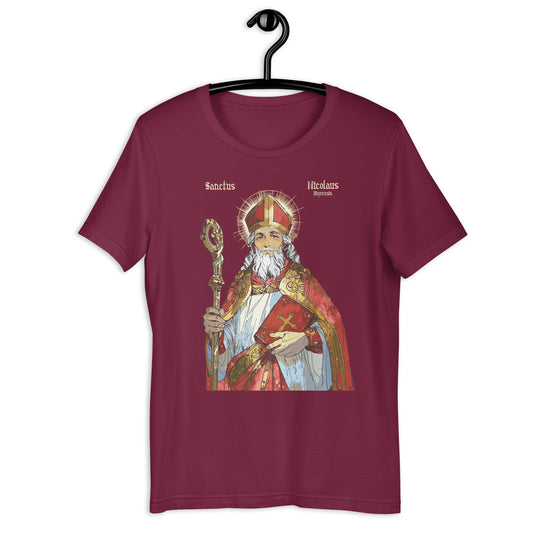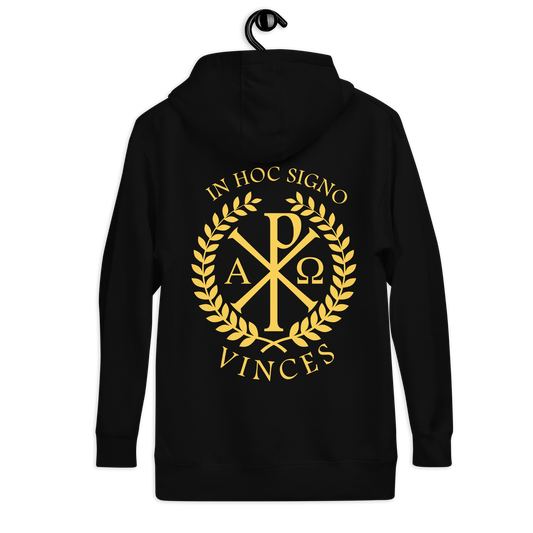Traditional Catholic attire might seem like a minor detail in church life but its meaning runs deeper than most imagine. Even today the Vatican still publishes official dress codes for visitors and clergy alike. What surprises many is that these clothing choices are not just about rules or old customs. They tell a powerful story of spiritual identity and connection that spans centuries and brings faith into everyday life.
Table of Contents
- What Is Traditional Catholic Attire?
- The Significance Of Traditional Attire In Catholicism
- Key Components Of The Traditional Catholic Attire List
- Cultural And Historical Context Of Catholic Dress
- Modern Adaptations And Influences On Catholic Fashion
Quick Summary
| Takeaway | Explanation |
|---|---|
| Traditional attire embodies faith and modesty. | Beyond fashion, traditional Catholic clothing signifies respect and spiritual expression in worship. |
| Modesty and dignity are essential principles. | Attire should cover appropriately and reflect respect for the sacred environment during religious occasions. |
| Clergy and lay attire serve distinct purposes. | Clergy wear specific vestments indicating spiritual roles, while lay clothing emphasizes modesty and respect in church settings. |
| Cultural significance of Catholic dress is profound. | Traditional attire connects believers to historical practices and represents communal identity within the Catholic faith. |
| Modern fashion can reflect traditional values. | Young Catholics are adapting traditional principles to contemporary styles, balancing reverence and personal expression in their clothing choices. |
What is Traditional Catholic Attire?
Traditional Catholic attire represents more than just clothing - it embodies a profound spiritual expression of reverence, modesty, and respect within religious settings. Catholic dress traditions reflect a deep understanding of presenting oneself with dignity and honor during liturgical celebrations and sacred moments.
Historical Roots of Catholic Clothing
Traditional Catholic attire has evolved through centuries of ecclesiastical practices, deeply rooted in principles of modesty and spiritual representation. These clothing traditions emerged not merely as fashion statements but as powerful symbols of faith and cultural identity. Women historically wore head coverings like veils during Mass, symbolizing humility and spiritual submission, while men typically dressed in formal, structured clothing that demonstrated respect for the sacred environment.
Principles of Traditional Catholic Dress
The fundamental principles guiding traditional Catholic attire center on several key aspects:
- Modesty: Clothing should cover the body appropriately, avoiding provocative or overly casual styles
- Reverence: Attire must demonstrate respect for the liturgical space and religious context
- Dignity: Garments should reflect the solemnity and beauty of Catholic worship
For modern Catholics seeking to understand and embrace these traditions, our guide on contemporary Catholic fashion offers deeper insights into balancing traditional principles with modern style sensibilities. Traditional Catholic attire is not about rigid restrictions but about expressing faith through thoughtful, dignified clothing choices that honor the sacred traditions of the Church.
The Significance of Traditional Attire in Catholicism
Traditional Catholic attire transcends mere clothing choices, representing a profound theological and cultural expression of faith, identity, and spiritual commitment. Liturgical vestments and dress traditions serve as powerful visual symbols that communicate deeper spiritual meanings within the Catholic tradition.
Spiritual Symbolism and Religious Identity
Catholic attire is not simply about aesthetic presentation but carries deep symbolic significance. Each element of traditional dress represents spiritual concepts and theological principles. Clergy vestments, for instance, symbolize sacred roles and spiritual authority, while traditional lay clothing reflects humility, reverence, and commitment to Christian values. These garments create a visual language that communicates spiritual dedication and ecclesiastical heritage.
Cultural and Theological Expressions
Traditional Catholic attire embodies multiple layers of meaning beyond immediate visual appearance:
- Spiritual Continuity: Connecting contemporary believers with centuries of religious tradition
- Theological Representation: Externally manifesting internal spiritual beliefs
- Communal Identity: Signaling membership in the broader Catholic community
For Catholics interested in exploring how clothing can be a form of evangelization, learn more about expressing faith through apparel. By understanding the profound significance of traditional attire, believers can appreciate how clothing becomes a meaningful medium of spiritual expression and cultural preservation.
Key Components of the Traditional Catholic Attire List
Traditional Catholic attire encompasses a comprehensive set of clothing elements that reflect spiritual reverence and liturgical traditions. Catholic clothing guidelines provide nuanced insights into appropriate dress for various religious contexts.
Liturgical and Lay Clothing Components
Traditional Catholic attire differentiates between clergy vestments and lay clothing, each serving distinct spiritual purposes. For clergy, this includes specific liturgical garments like the alb, chasuble, and stole. Lay Catholics traditionally emphasize modest, dignified clothing that demonstrates respect for sacred spaces and religious celebrations.
The following table compares traditional Catholic attire for clergy and laypeople, outlining the distinctive elements and underlying principles that define each group.
| Group | Key Garments / Features | Purpose / Spiritual Meaning |
|---|---|---|
| Clergy | Alb, Chasuble, Stole | Symbolize sacred roles, purity, authority, and reverence |
| Lay Catholics | Head coverings (for women), formal modest attire, minimal accessories | Express modesty, humility, respect for sacred environment |
Essential Elements of Traditional Catholic Dress
The key components of traditional Catholic attire vary between clergy and laity but share fundamental principles of modesty and reverence:
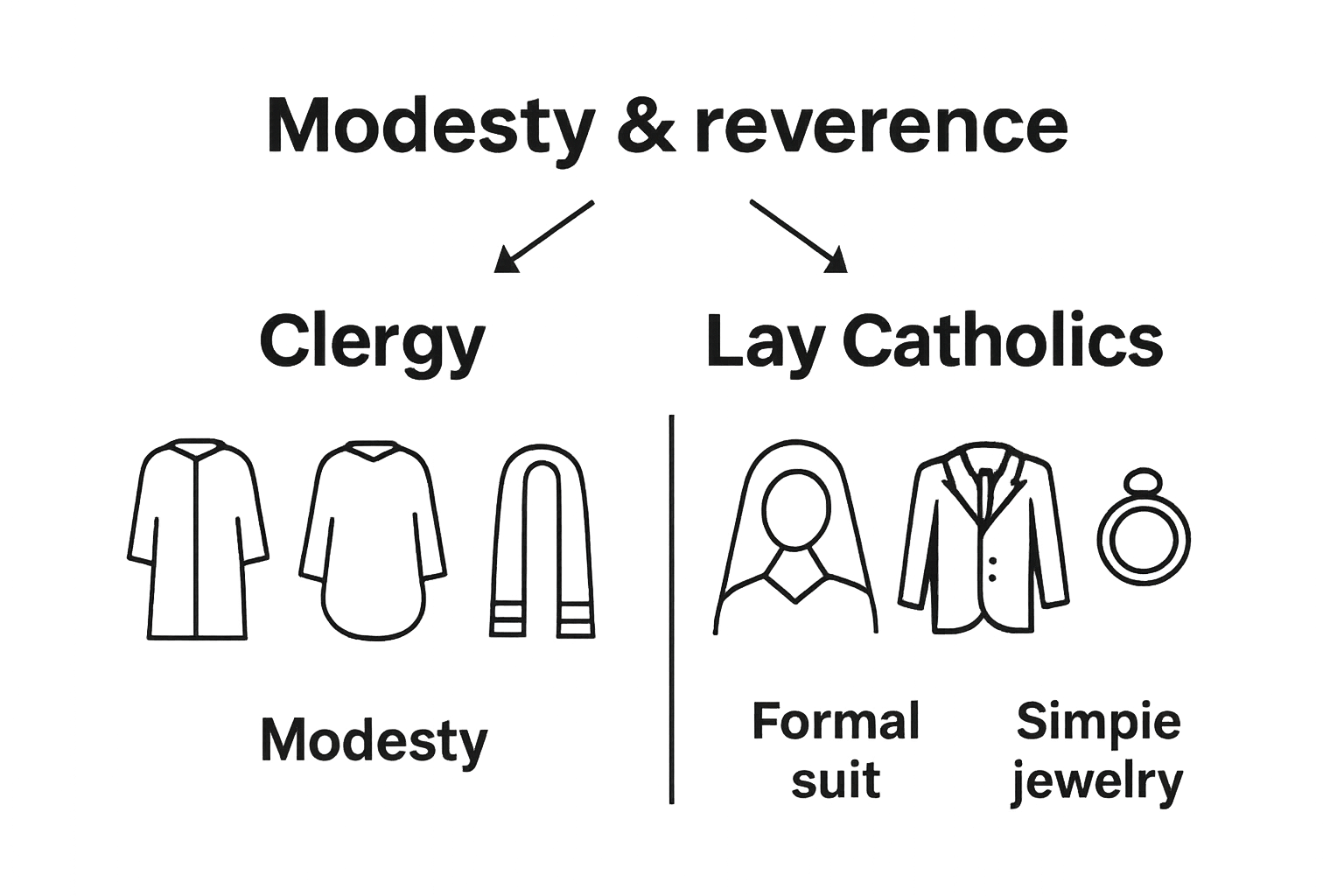
For Clergy:
- Alb: A white liturgical vestment symbolizing purity
- Chasuble: An outer liturgical garment worn during Mass
- Stole: A long ceremonial scarf representing spiritual authority
For Lay Catholics:
- Head Coverings: Traditional veils or modest head coverings for women
- Formal Attire: Structured, modest clothing for church services
- Respectful Accessories: Minimal, understated jewelry and accessories
Explore contemporary approaches to Catholic clothing styles to understand how traditional principles adapt to modern fashion sensibilities. Traditional Catholic attire remains a powerful expression of faith, bridging timeless spiritual values with contemporary aesthetic sensibilities.
Cultural and Historical Context of Catholic Dress
Catholic dress traditions represent a rich tapestry of spiritual and cultural evolution, deeply intertwined with centuries of religious practice and social transformation. Historical Catholic clothing research reveals how attire has been a powerful medium of expressing faith, cultural identity, and theological principles.
Ecclesiastical Influences on Clothing Traditions
Throughout history, Catholic dress has been profoundly shaped by ecclesiastical developments and theological interpretations. Medieval periods saw elaborate liturgical vestments emerging as symbolic representations of spiritual roles, with each garment carrying deep theological significance. Clergy clothing, in particular, evolved to distinguish sacred ministerial functions from everyday secular attire, creating visual markers of spiritual authority and commitment.
Evolution of Dress Across Different Historical Periods
Catholic clothing traditions have undergone significant transformations, reflecting broader social and cultural changes:
- Medieval Period: Highly structured ecclesiastical dress with strong symbolic meanings
- Renaissance Era: Increased artistic elaboration of liturgical vestments
- Modern Period: Gradual simplification while maintaining core spiritual principles
Discover contemporary approaches to maintaining Catholic style principles and understand how traditional dress continues to adapt. The ongoing evolution of Catholic attire demonstrates a dynamic relationship between timeless spiritual values and changing cultural contexts, ensuring that clothing remains a meaningful expression of faith across generations.
This table summarizes how Catholic attire has evolved over major historical periods, highlighting the defining characteristics and cultural influences of each era.
| Historical Period | Attire Characteristics | Notable Developments |
|---|---|---|
| Medieval Period | Highly structured ecclesiastical dress, strong symbolism | Distinct clergy/laity visual differences |
| Renaissance Era | Artistic elaboration of vestments, ornate decorations | Increased emphasis on liturgical beauty |
| Modern Period | Simplification of garments, focus on core principles | Adaptation to contemporary sensibilities |
Modern Adaptations and Influences on Catholic Fashion
Contemporary Catholic fashion represents a dynamic intersection of traditional spiritual principles and modern aesthetic sensibilities. Catholic fashion trends reveal a nuanced approach to expressing faith through clothing that respects historical traditions while embracing contemporary style.
Emerging Trends in Catholic Attire
Modern Catholic fashion has witnessed significant transformations, balancing reverence with personal expression. Young Catholics are reimagining traditional dress codes, creating clothing that communicates spiritual identity while remaining stylish and relevant. This shift demonstrates a creative approach to maintaining religious principles without sacrificing individual aesthetic preferences.
Technological and Cultural Influences
Several key factors are reshaping Catholic fashion in the contemporary landscape:
- Digital Culture: Social media platforms enabling global fashion conversations
- Generational Shifts: Younger Catholics reinterpreting traditional dress codes
- Globalization: Increased cultural exchange and diverse fashion influences
Explore contemporary Catholic clothing approaches that bridge traditional reverence with modern design sensibilities. The evolution of Catholic fashion represents more than clothing trends it embodies a profound dialogue between timeless spiritual values and the dynamic cultural expressions of faith in the 21st century.
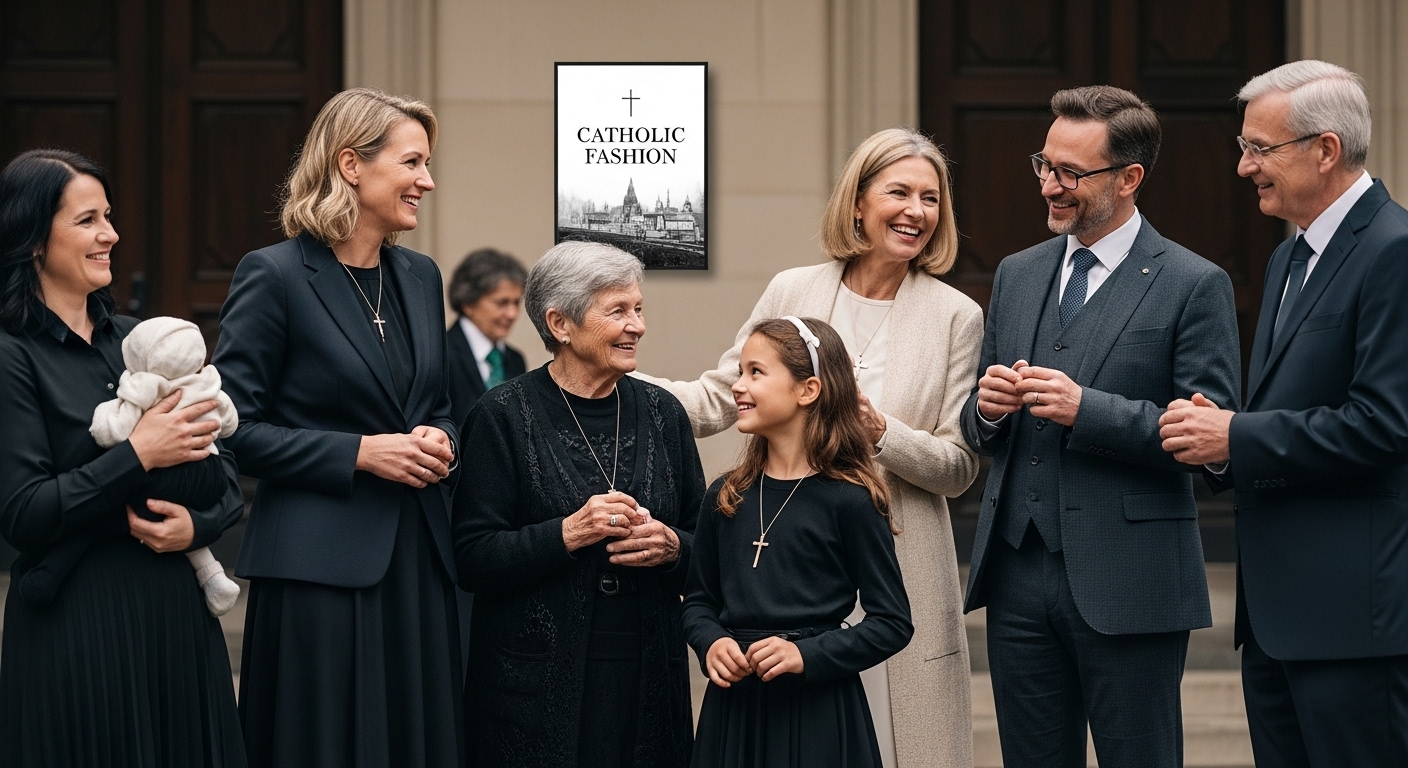
Bring Traditional Catholic Attire Into Your Everyday Life
If you are inspired by the rich meaning behind traditional Catholic clothing and want to reflect your faith authentically, your search does not have to stop at understanding the list. Traditional attire is about reverence, modesty, and confidence in your beliefs. Many Catholics today struggle to find clothing that connects faith and modern style. We know it can be hard to find quality pieces that help you share your values outside of church without feeling out of place.
Explore our Catholic T-Shirts collection where each design honors Catholic tradition but fits today’s fashion. Our apparel is more than a statement—it is a conversation starter and a gentle way to evangelize.

Ready to wear your faith boldly and beautifully? Visit Deus Design now and discover clothing and gifts that let you live out your values in every setting. Check out our curated Gifts for Catholics for items that celebrate the richness of Catholic heritage. Choose to make your presence a visible sign of tradition and faith today.
Frequently Asked Questions
What are the key principles of traditional Catholic attire?
Traditional Catholic attire is guided by principles of modesty, reverence, and dignity, ensuring that clothing choices reflect respect for the sacred environment and liturgical context.
What types of clothing are included in the traditional Catholic attire list for clergy?
Clergy traditional attire includes specific liturgical garments such as the alb, chasuble, and stole, each having its own spiritual significance and purpose during Mass and other religious services.
How does traditional Catholic attire differ for laypeople compared to clergy?
Lay Catholics typically emphasize modest, dignified clothing that demonstrates respect for sacred spaces, whereas clergy attire includes specialized vestments that denote spiritual authority and roles within the Church.
Why is modesty important in traditional Catholic dress?
Modesty is crucial in traditional Catholic dress as it reflects a profound respect for the sacred, avoids distraction during worship, and embodies a spirit of humility and reverence towards faith and community.


